SAML 2.0
Introduction
What is SSO (Single Sign On)
Some definitions
- Authentication Verifying an identify
- Authorization Verifying user has permission and access
- Federation is when authentication is happen across multi vendor apps
SSO is the ability to authenticate via one authority.
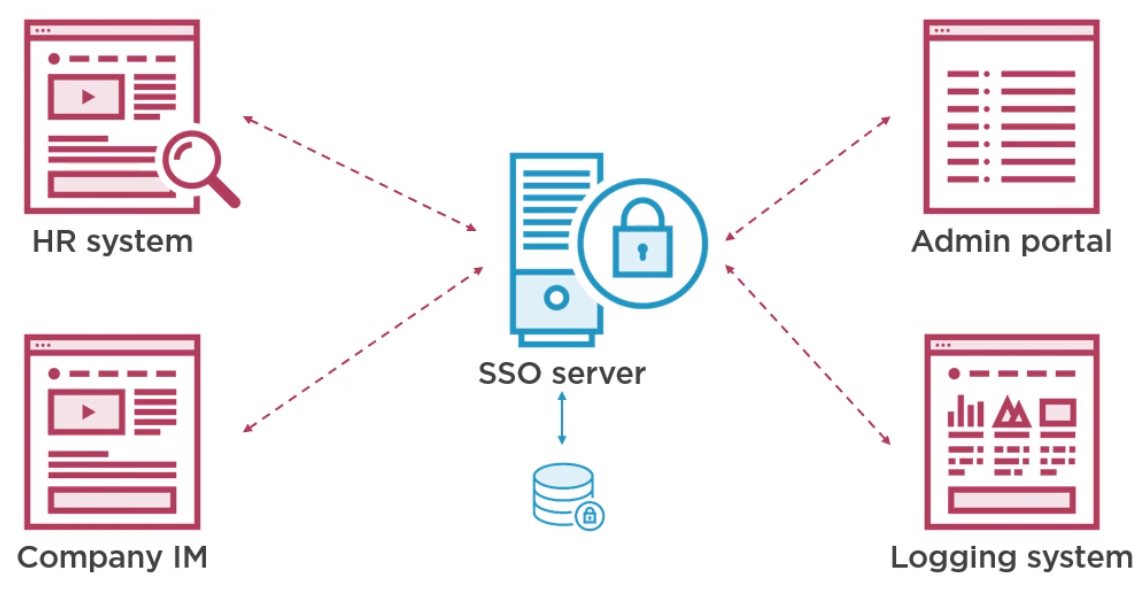
Benefits are
- Authentication under your control (Audit, turn off/on etc)
- One set of credentials
- Login once per session
SAML
SAML stands for Security Assertion Markup Language and defines the syntax and processing semantics of assertions made about a subject by a system entity.
In SAML the thing providing the service is the Service Provider (SP) e.g. HR System and the thing providing the Authentication is the Identity Provider (IdP)
Here is an example for a typical workflow where Citrix is the service provider.
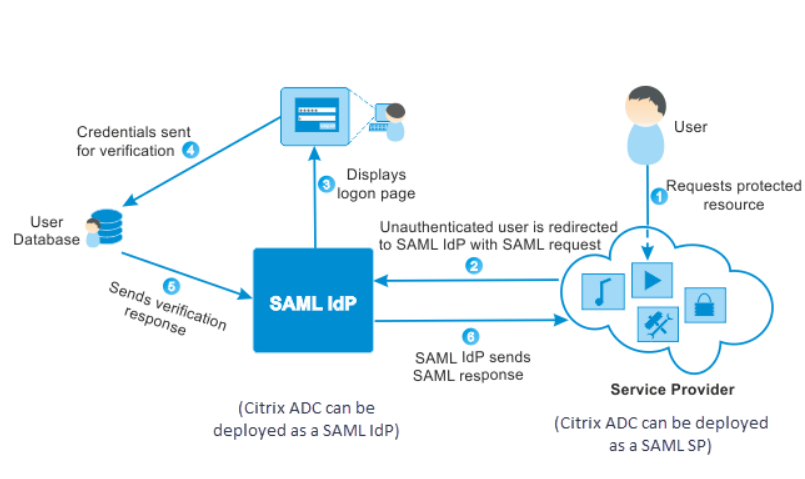
If you already have a session and want to access a second service provider no credentials are prompted for and you are logged in automatically.
History
Here is a timeline for some of the protocols in use today in this space.

SAML 1.0 and 1.1 are dead as they relied on SOAP.
For SAML 2.0 parts of the specification are :
Not really used now
- Authorization functionality
- Name ID Management & mapping profiles
Are used
- Web SSO (Single Sign on)
- SLO (Single Logout)
- Artifact Binding
SAML vs OpenID
- SAML
- Created before OpenID Connect 2005
- Uses XML and XMLSig which has created security issues
- Designed for Server-side Web Apps
- Poor support for JavaScript SPA or Native App like mobile App with Url length limits
- Implementation is split between service and the Identify Provider
- OpenID Connect
- Newer than SAML Created in 2014
- Uses JSON and JWTs
- Built on OAuth and supports API access and delegation
- Designed for all modern authentication types including browserless e.g. TV
- Implementation is largely in the Identify Provider
SAML Detail
Introduction
More terminalogy. Auth requests are sent to the IdP SSO endpoint and responses are returned to the Service Providers ACS Endpoint
- SSO Endpoint Single Sign on Endpoint
- ACS Endpoint Assertion Consumer Service Endpoint
Relay State
A RelayState is an HTTP parameter that can be included as part of the SAML request and SAML response. In an SP-initiated sign-in flow, the SP can set the RelayState parameter in the SAML request with additional information about the request.
It is the equivalent of a forgery token to deter Open Redirect.
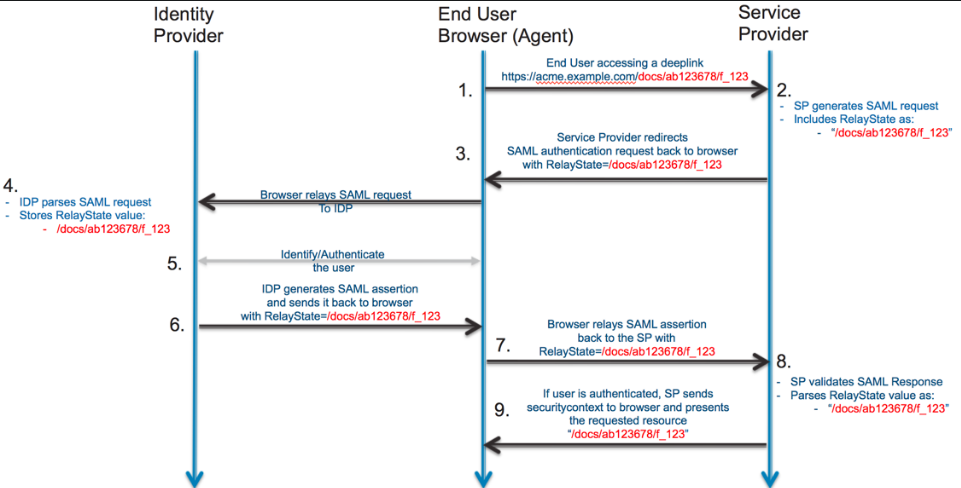
Binding Types
SAML provides several ways to communicate from the Service Provider to the Identity Provider and vice-versa. These are known as binding types.
Auth Request
Example SAML Auth Request
Here is an example Auth Request
<samlp:AuthnRequest xmlns:samlp="urn:oasis:names:tc:SAML:2.0:protocol" xmlns:saml="urn:oasis:names:tc:SAML:2.0:assertion" ID="ONELOGIN_809707f0030a5d00620c9d9df97f627afe9dcc24" Version="2.0" ProviderName="SP test" IssueInstant="2014-07-16T23:52:45Z" Destination="http://idp.example.com/SSOService.php" ProtocolBinding="urn:oasis:names:tc:SAML:2.0:bindings:HTTP-POST" AssertionConsumerServiceURL="http://sp.example.com/demo1/index.php?acs">
<saml:Issuer>http://sp.example.com/demo1/metadata.php</saml:Issuer>
<samlp:NameIDPolicy Format="urn:oasis:names:tc:SAML:1.1:nameid-format:emailAddress" AllowCreate="true"/>
<samlp:RequestedAuthnContext Comparison="exact">
<saml:AuthnContextClassRef>urn:oasis:names:tc:SAML:2.0:ac:classes:PasswordProtectedTransport</saml:AuthnContextClassRef>
</samlp:RequestedAuthnContext>
</samlp:AuthnRequest>
Common Attributes to Messages
These three attributes are required for every message type. The ID is the unique message identifier and is provided in the response. The IssueInstant is the UTC time the message was created.
<samlp:AuthnRequest xmlns:samlp="urn:oasis:names:tc:SAML:2.0:protocol" xmlns:saml="urn:oasis:names:tc:SAML:2.0:assertion"
...
ID="ONELOGIN_809707f0030a5d00620c9d9df97f627afe9dcc24"
Version="2.0"
IssueInstant="2014-07-16T23:52:45Z"
...
</samlp:AuthnRequest>
Destination Attribute
Another value present of all messages is the Destination attribute although this is optional. It is recommended to enforce use of this where possible.
Where To Send Attributes
These two below show where to send the response and which binding type to use and must be known to the IdP
<samlp:AuthnRequest xmlns:samlp="urn:oasis:names:tc:SAML:2.0:protocol" xmlns:saml="urn:oasis:names:tc:SAML:2.0:assertion"
...
ProtocolBinding="urn:oasis:names:tc:SAML:2.0:bindings:HTTP-POST" AssertionConsumerServiceURL="http://sp.example.com/demo1/index.php?acs">
...
</samlp:AuthnRequest>
Issuer
Finally we have the Issuer which must be known to the IdP.
<samlp:AuthnRequest xmlns:samlp="urn:oasis:names:tc:SAML:2.0:protocol" xmlns:saml="urn:oasis:names:tc:SAML:2.0:assertion"
...
<saml:Issuer>http://sp.example.com/demo1/metadata.php</saml:Issuer>
...
</samlp:AuthnRequest>
Popular Options
ForceAuthn
This can be added to force the credentials to be entered even if previously done so. E.g. change password.
RequestedAuthContext
This is where you can request 2FA for instance. These need to be agreed in the IdP and the SP.
Scoping
This is where the SP provides to the IdP a list of other providers which should used for the authentication. E.g. Google. This can then be very specific where authentication takes place.
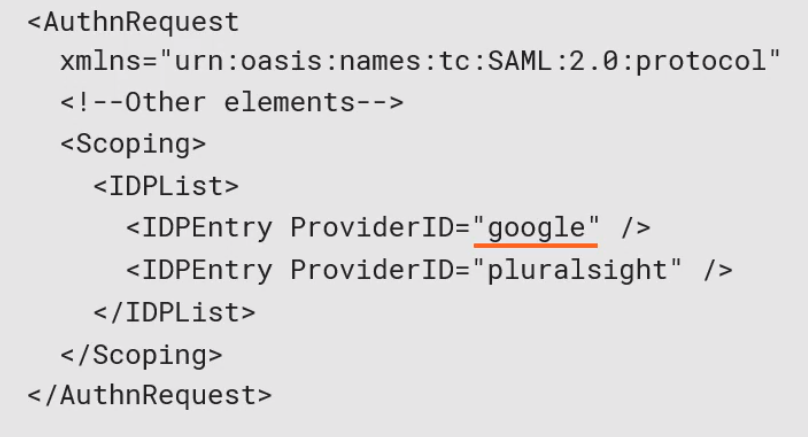
Auth Response
Example SAML Auth Response
Here is an example Auth Response
<samlp:Response xmlns:samlp="urn:oasis:names:tc:SAML:2.0:protocol" xmlns:saml="urn:oasis:names:tc:SAML:2.0:assertion" ID="_8e8dc5f69a98cc4c1ff3427e5ce34606fd672f91e6" Version="2.0" IssueInstant="2014-07-17T01:01:48Z" Destination="http://sp.example.com/demo1/index.php?acs" InResponseTo="ONELOGIN_4fee3b046395c4e751011e97f8900b5273d56685">
<saml:Issuer>http://idp.example.com/metadata.php</saml:Issuer>
<samlp:Status>
<samlp:StatusCode Value="urn:oasis:names:tc:SAML:2.0:status:Success"/>
</samlp:Status>
<saml:Assertion xmlns:xsi="http://www.w3.org/2001/XMLSchema-instance" xmlns:xs="http://www.w3.org/2001/XMLSchema" ID="_d71a3a8e9fcc45c9e9d248ef7049393fc8f04e5f75" Version="2.0" IssueInstant="2014-07-17T01:01:48Z">
<saml:Issuer>http://idp.example.com/metadata.php</saml:Issuer>
<saml:Subject>
<saml:NameID SPNameQualifier="http://sp.example.com/demo1/metadata.php" Format="urn:oasis:names:tc:SAML:2.0:nameid-format:transient">_ce3d2948b4cf20146dee0a0b3dd6f69b6cf86f62d7</saml:NameID>
<saml:SubjectConfirmation Method="urn:oasis:names:tc:SAML:2.0:cm:bearer">
<saml:SubjectConfirmationData NotOnOrAfter="2024-01-18T06:21:48Z" Recipient="http://sp.example.com/demo1/index.php?acs" InResponseTo="ONELOGIN_4fee3b046395c4e751011e97f8900b5273d56685"/>
</saml:SubjectConfirmation>
</saml:Subject>
<saml:Conditions NotBefore="2014-07-17T01:01:18Z" NotOnOrAfter="2024-01-18T06:21:48Z">
<saml:AudienceRestriction>
<saml:Audience>http://sp.example.com/demo1/metadata.php</saml:Audience>
</saml:AudienceRestriction>
</saml:Conditions>
<saml:AuthnStatement AuthnInstant="2014-07-17T01:01:48Z" SessionNotOnOrAfter="2024-07-17T09:01:48Z" SessionIndex="_be9967abd904ddcae3c0eb4189adbe3f71e327cf93">
<saml:AuthnContext>
<saml:AuthnContextClassRef>urn:oasis:names:tc:SAML:2.0:ac:classes:Password</saml:AuthnContextClassRef>
</saml:AuthnContext>
</saml:AuthnStatement>
<saml:AttributeStatement>
<saml:Attribute Name="uid" NameFormat="urn:oasis:names:tc:SAML:2.0:attrname-format:basic">
<saml:AttributeValue xsi:type="xs:string">test</saml:AttributeValue>
</saml:Attribute>
<saml:Attribute Name="mail" NameFormat="urn:oasis:names:tc:SAML:2.0:attrname-format:basic">
<saml:AttributeValue xsi:type="xs:string">test@example.com</saml:AttributeValue>
</saml:Attribute>
<saml:Attribute Name="eduPersonAffiliation" NameFormat="urn:oasis:names:tc:SAML:2.0:attrname-format:basic">
<saml:AttributeValue xsi:type="xs:string">users</saml:AttributeValue>
<saml:AttributeValue xsi:type="xs:string">examplerole1</saml:AttributeValue>
</saml:Attribute>
</saml:AttributeStatement>
</saml:Assertion>
</samlp:Response>
InResponseTo
This is always included in the SAML Message and is used to verify a valid response for the request.
<samlp:Response xmlns:samlp="urn:oasis:names:tc:SAML:2.0:protocol" xmlns:saml="urn:oasis:names:tc:SAML:2.0:assertion"
...
InResponseTo="ONELOGIN_4fee3b046395c4e751011e97f8900b5273d56685">
...
</samlp:Response>
Status
This provides the status of the processing and an optional StatusMessage or StatusDetail. To be a successful response must contain a SAML Assertion (It can contain more).
SAML Assertions
An Assertion will contain attributes
- Subject User details and how to verify the subject
- Conditions Authentication Details
- AttributeStatement User details
- AuthStatement Authentication Details
Subject
This provides a method to confirm the subject. The main approach is something called the bearer method which states possession of the assertion and subject is enough to verify the user. (I am assuming this message)
Conditions
This include expiry times for the assertions. This may also contain the AudienceRestriction and as an SP you should validate the value is you.
AttributeStatement
This describes the authentication event. It contains the Authentication Context which show how the use authenticated.
AuthStatement
Like OAuth claims and contains identity data like first name, last name.
NameID Format
Introduction
This should be opaque i.e. not recognizable like name and should not be changeable (immutable).
Pairwise
This allows for a Unique ID per service Provider.
SAML Signing
Signing is done using public/private key. It is recommended that you do sign requests but a lot of implementations do not. For responses it is recommended you sign the assertion and the outer most element which contains the assertion.
SAML Redirect Binding
This is where the SP issues a 302 (Redirect) to the IdP in the query string.
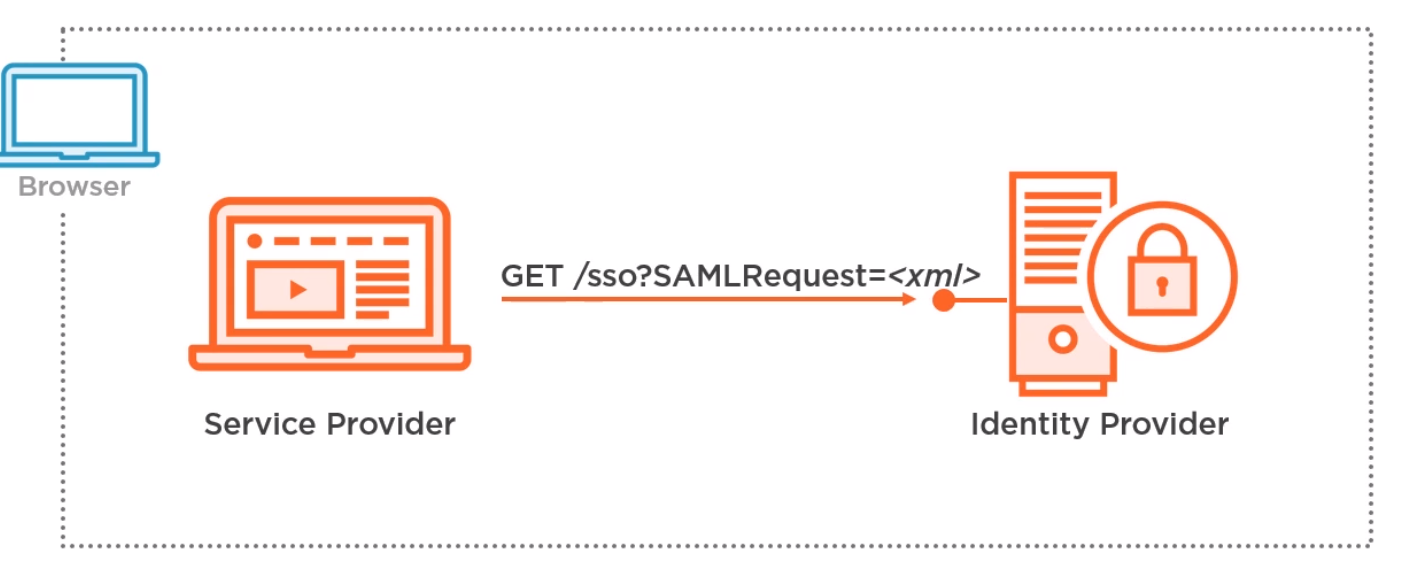 To make the protocol message fit the message is
To make the protocol message fit the message is
- Compressed using the Deflate Algorithm
- Base64 Encoded
- Url Encoded
- Assigned to the SAMLRequest or SAMLResponse query Parameter
- Relay State is encoded and added in the RelayState query parameter
- Signature Algorithm is encoded add added in the SigAlg query parameter
SAML POST Binding
This posts the response to the recipient directly and removes the query string length restrictions add better security with https in the body. To Post data and redirect the user to recipient SAML uses Form post with a self submitting form.
SAML Artifact Binding
Here is the Artifact Structure
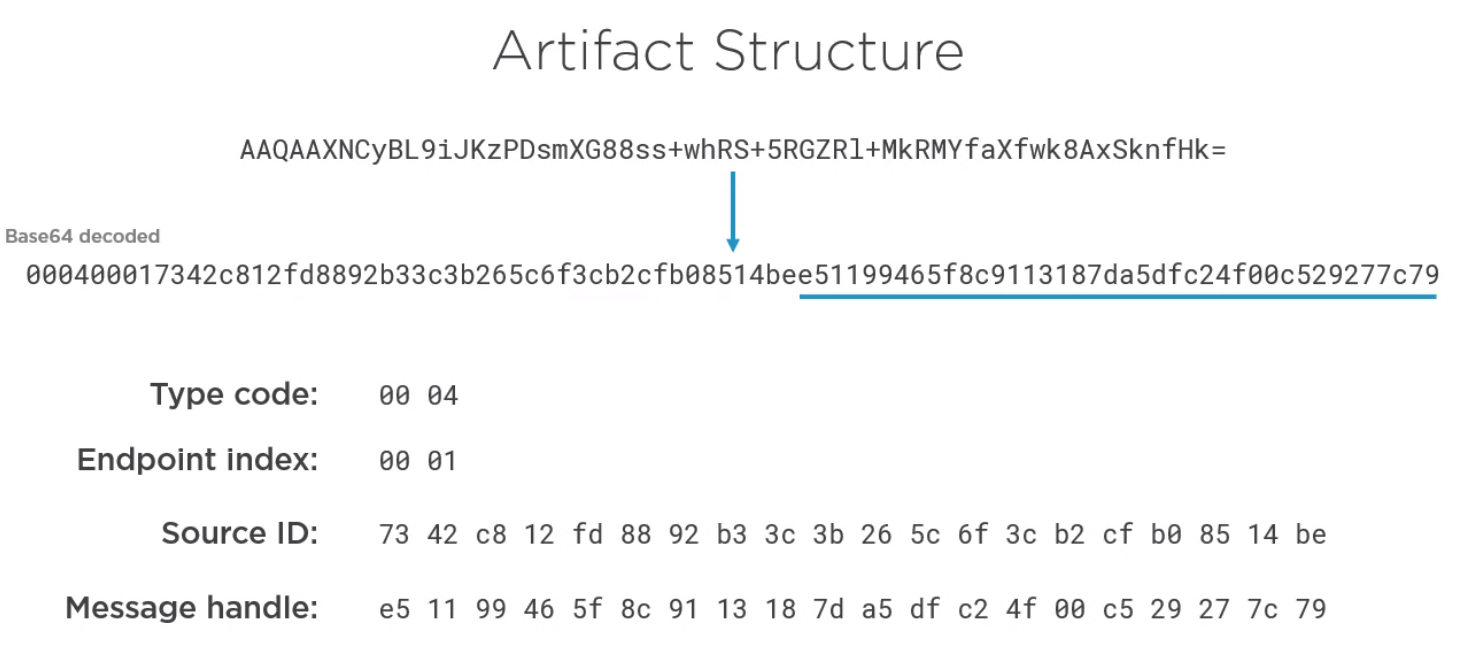
- Type Code is always the same value
- Endpoint Index references the artifact resolution service endpoint where the artifact should be swapped.
- Source ID is entity of the provider who created the artifact
- Cryptographic handle to the message which created the artifact